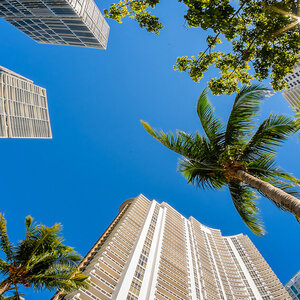The WPJ
THE WORLD PROPERTY JOURNALReal Estate Facts Not Fiction
Residential Real Estate News

Falling Oil Prices Creating Strong Headwinds for UAE Property Markets
Residential News » U.A.E. (Abu Dhabi) Edition | By Michael Gerrity | September 1, 2015 10:59 AM ET
According to international real estate consultancy firm Cluttons, with a 54% decline in the price of oil uring the past 12 months the United Arab Emirates (UAE) real estate market is now beginning to feel the effect with property transaction levels falling across Abu Dhabi, Dubai and Sharjah.
Cluttons' annual 2015 UAE Property Report reveals that the direct correlation between hydrocarbon revenues and state spending will put pressure on the rate of job creation. A further reduction in is oil prices is also likely once Iran receives the green light to begin oil exports. In turn, this will impact on the rate of office space take up and subsequently, the creation of households and overall residential demand. The impact is expected to be variable across the nation's three largest emirates. However, the return of an Iranian variable to the national real estate equation could be particularly momentous for the real estate market.
Key UAE Property Market Highlights Include:
- Transaction levels falling across Abu Dhabi, Dubai, Sharjah
- Oil price decline impacting job creation affecting real estate
- Affordability and supply levels impacting villa market
- Boost from Iranian investors expected once sanctions lifted
- ·Rental market weak but strong tourism sector and Expo 2020 boost medium term outlook
Cluttons Middle East chief executive Steve Morgan says, "We see a number of economic factors at play which will impact the level of transactions in the near term. The decline in oil prices has seen the government take necessary fiscal measures to boost its financial position, including the deregulation of fuel prices and the much talked about future move towards the introduction of VAT and corporation tax. These initiatives will likely cause consumer price inflation levels to increase, resulting in a reluctance of tenants to pay higher end rents and families to purchase homes. However, some of the rises may be off-set by the fall in diesel prices, helping to maintain the UAE's competitive edge, which is unchallenged in the region.
"With the expected lifting of Iranian trades sanctions, it is our view that Iranian nationals will seize the opportunity to make significant real estate investments in the UAE, particularly Dubai, pushing them back up the buyer nationality league table. In 2010, Iranian nationals accounted for 12% of Dubai's real estate transactions, positioning them in fourth place behind Indian, British and Pakistani nationals. Data from the Dubai Land Department on investment volumes showed investment from Iranian's had dwindled to a low of just 3% during the first quarter of 2015."
Residential
In Abu Dhabi, house prices across the capital slipped by 0.2% in the second quarter of 2015, the first contraction since Q3 2012, and leaves the current average house price standing at AED 1,336 psf. Demand remains stable in the top-end luxury market according to the report, and more affordable sub AED 1,000 psf properties. This is driven by affluent Emirati and GCC buyers continuing to home in on schemes based on perceived exclusivity, while the large expat population that is being squeezed out of the rental market due to rampant rental growth, is targeting more affordable properties that are perceived as better value for money.
The Cluttons report points to a 1.5% rise in average rents, registered during the second quarter, pushing annual growth in the capital up to 3.9%. Hydra Village was the strongest performing submarket, with rents for three bedroom for villas surging by almost 32% during the first six months of the year to AED 125,000 per annum.
Faisal Durrani, Head of Research at Cluttons commented, "With government spending subsiding, the rate of job creation and residential demand is also expected to stabilise. With this in mind, it is our view that the residential market will see further slight to moderate price falls over the remainder of 2015. Overall, quarterly house price declines of between 0.5% and 1% can be expected in both Q3 and Q4, while rents are expected to remain largely flat during H2."
In Dubai, the total number of residential real estate transactions has remained fairly stable this year, according to data from Reidin. There has been almost no change in average apartment values during H1 2015, with a 0.6% fall recorded between January and June.
Durrani added: "The villa market continues to bear the brunt of the Federal Mortgage Cap restrictions, which have made affordability a central issue for potential buyers who are now required to hold significant equity to fund upfront costs. Values on average declined by 3.4% during Q2, bringing the annual rate of change down to -7%. We expect a further 5% to 7% fall in villa values is expected this year as supply levels rise and affordability issues challenge buyers".
Cluttons' report shows that during the second quarter of this year, average rents in Dubai declined by 0.9%, taking the overall change in the six months to June to -1.3%. Apartments in affordable communities have held steady in 2015, while the villa market has witnessed a 1% drop during Q2. Looking further ahead, the rental market is set to be boosted by Expo 2020 moving from being on the medium-term event horizon to the short term, with infrastructure projects moving forward and in turn supporting job creation. The expected population growth to 2.8 million by 2020 will also help to increase demand for space.
Durrani continued: "We expect the sales market to weaken further this year based on a combination of the Federal Mortgage Cap, affordability challenges and a strengthening supply pipeline, which has seen 41,000 new units announced already this year. It is our view that the rental market will continue to perform at a reasonably stable level, with further declines in the region of 1.5% to 2% likely during the second half of the year. The severity of the decline is being hugely offset by the strong rate of job creation and population growth, which remains stable, strong and diverse".
In Sharjah, tenants are now firmly in the driving seat as the lettings market slows in response to declines in Dubai and the introduction of what is perceived to be high-quality accommodation in neighbouring Ajman. The Emirate recorded a 2.3% dip in average rents, yet these still stand 3.3% ahead of this time last year. Apartments registered a 4.2% decline during the second quarter, while villa rents edged up slightly by 1.4%.
"In the sales market, world-class master planned communities such as Al Zahia and Tilal City are quietly growing in popularity and setting the benchmark for future master planned communities. These affordable upscale developments, which are designed around the emirate's rich Islamic heritage are allowing for the emergence of a niche residential market that caters for families who have been priced out of other UAE markets and those that have been waiting for more affordable communities in surroundings that echo their more traditional lifestyles", said Durrani.
Commercial
The report indicates that the lifting of trade sanctions on Iran could boost the UAE's economic activity. Prior to the introduction of the sanctions, Iran was the UAE's biggest trading partners, while in the past both local and global businesses hubbed any Iranian operations out of Dubai.
Morgan continued: "We have already noted an upturn in speculative requirements from Dubai-based Iranian businesses looking to expand their premises in anticipation of a resumption in normal trade with Iran. Furthermore, we have also already noted several instances of Iranian businesses in the emirate approaching banks for loans to fund planned expansion".
In addition, Cluttons anticipates an upturn in international businesses looking to service any Iranian operations out of Dubai, which will once again place upward pressure on Grade A rents in sought after submarkets, particularly the city's primary free zones such as the DIFC, the Internet and Media Cities, D3 and Dubai Airport Free Zone.
During the first six month of 2015, headline office space for primary, secondary and tertiary space was unchanged at AED 250 psf, AED 130 psf and AED 70 psf, respectively. This does however mask a more complex picture at a submarket level across the city. And there are exceptions to average rates, with Emirates Towers and core DIF space for instance recently quoting between AED 275 psf and AED 300 psf.
Cluttons latest research also shows that in Abu Dhabi the office market's recent stagnation is in large part linked to the slowdown in public spending, which has translated into a drop in demand for new office space.
Durrani explained, "However, due to a general lack of supply, particularly at the Grade A end of the market, rents have held steady and are expected to remain stable over the course of 2015, with occupancy levels close to 100%. Prime rents, which stand at AED 1,850 psm, have remained stable for an extraordinary 14 quarters and super-prime buildings such as the newly established Abu Dhabi Global Market Square on Al Maryah Island continues to cement its position as the city's 'ultra-prime' office benchmark with rents standing at approximately AED 3,700 psm, which is catering to a niche market of occupiers who need to be in Abu Dhabi.
"Abu Dhabi's dependence on hydrocarbon revenues has meant that the rate of office take up, which is traditionally dominated by oil and gas companies has cooled significantly. This is likely to put increased downward pressure on more secondary and tertiary locations in the first instance, with prime rents likely to face headwinds at the beginning of 2016."
For Sharjah, office rents in the main submarkets held steady during the second quarter, following no change in Q1. The flat performance of the office market reflects a scaling back in overall requirements and take up levels while the dominant oil and gas occupiers assess their expansion plans. The ability of the market to weather the continued low oil price environment, or weakening demand, is expected to put rents under pressure, particularly at the top of the market.
Morgan concluded: "In more secondary and tertiary locations landlords are adjusting rents downwards in an effort to generate demand. This widening gap between the two tiers of the market is unlikely to be sustainable, with Grade A rents likely to slip later on in the year. Overall, rent declines of up to 5% are likely across the board before the end of the year."
Sign Up Free | The WPJ Weekly Newsletter
Relevant real estate news.
Actionable market intelligence.
Right to your inbox every week.
Real Estate Listings Showcase
Related News Stories
Residential Real Estate Headlines
- U.S. Home Sales Continue Slump in April Despite Growing Inventory
- Opportunity Zone Home Prices Surpass National Growth in Half of U.S. Markets
- Spring Home Sales Sputter in U.S. as High Costs Weigh on Buyers
- Ireland's Residential Rents Surge in Early 2025, Fastest Rise in Two Decades
- U.S. Homebuilder Confidence Drops Sharply in May, Hits 3 Year Low
- U.S. Cities Where Renters Need $100K Salary to Live Doubles Since 2020
- Tuscany's Property Boom Driven by Wealthy Foreign Buyers
- Home Price Appreciation Continues to Slow in U.S.
- California Home Sales Dip in March Amid Rising Economic Concerns
- U.S. Mortgage Rates Continue Downward Trend
- Pending Home Sales in U.S. Increase in March
- U.S. Home Values Flatline in March as Sellers Outnumber Buyers
- Greater Miami Area Residential Sales Cool in March
- NAR Reports Existing Home Sales Tumble in March, Hit 16-Year Low
- U.S. New Home Sales Uptick in March
- Florida's California Moment: Skyrocketing Housing, HOA and Insurance Costs Take Center Stage in 2025
- Home Seller Concessions Climbing as Market Conditions Shift in U.S.
- SENTIENT MORTGAGE Consumer-to-Lender AI Matching Engine Commences Development
- U.S. Homes Sold at Slowest Pace in 6 Years in March, Demand Sluggish
- Trump Tariffs Test U.S. Housing Markets Reliance on International Trade
- India Home Prices Nationwide Climbed 9 Percent Annually in 2024
- U.S. Home Remodeling Industry Sentiment Declines in Early 2025
- Canadian Home Sales Slide in February Amid U.S. Trade Tensions
- Americans Spent $603 Billion on Home Remodeling Projects in 2024
- U.S. Mortgage Demand Spikes 20 Percent in Early April as Rates Drop
- Las Vegas Area Home Prices Uptick 4.3 Percent Annually in March
- Single-Family Rent Growth in U.S. Trends Upward in 2025
- U.S. Mortgage Rates Tick Down Post Trump Tariffs Commencement
- President Trump's 'Liberation Day' Tariffs Potential Impact on the U.S. Housing and Mortgage Markets
- Baby Boomers Biggest Cohort of U.S. Home Buyers in 2025 as Millennials Decline
- U.S. Monthly Housing Payments Hit Record High in 2025
- U.S. Pending Home Sales Uptick in February
- Global Prime Residential Rent Slowdown Continued in Late 2024
- Ireland Home Price Inflation Hits 8 Year High in Early 2025
- Existing Home Sales in America Uptick in February
- Great Miami Area Residential Sales Decline 15 Percent Annually in February
- Mortgage Rates Uptick in Mid-March, Ending 9-Week Decline in U.S.
- World Property Ventures Builds the Future of Real Estate with New Funding Round
- U.S. Builder Sentiment Declines Amid Economic Uncertainty and Rising Costs
- Black Homeownership Rates in U.S. Enjoy Largest Annual Increase of All Racial Groups
Reader Poll
Marketplace Links
This website uses cookies to improve user experience. By using our website you consent in accordance with our Cookie Policy. Read More





